-
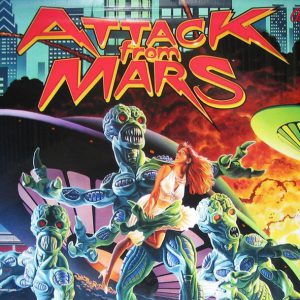 This four-player machine is almost always considered to be in the top five best solid-state games of its genre. Brian Eddy designed this machine with art by Doug Watson. 3,450 examples of it were made. This fast-paced game is not based on the “Mars Attacks” movie but ironically came out the same time as the movie’s release. A sequel to this game is also in the museum by the name “Revenge From Mars.” The main theme of this amusing game is to complete the five attack waves activated by hitting the three drop targets in front of the saucer. Doing so drops the targets and allows shots to the saucer. After so many saucer hits, the saucer explodes into a flurry of strobe lights (first time used on a pinball machine) and sounds. If you make it to Mars Attacks, the game goes into hyper mode with a flurry of options and actions. Total annihilation of Mars is the ultimate goal. Many more feats and multi-balls are also present.
This four-player machine is almost always considered to be in the top five best solid-state games of its genre. Brian Eddy designed this machine with art by Doug Watson. 3,450 examples of it were made. This fast-paced game is not based on the “Mars Attacks” movie but ironically came out the same time as the movie’s release. A sequel to this game is also in the museum by the name “Revenge From Mars.” The main theme of this amusing game is to complete the five attack waves activated by hitting the three drop targets in front of the saucer. Doing so drops the targets and allows shots to the saucer. After so many saucer hits, the saucer explodes into a flurry of strobe lights (first time used on a pinball machine) and sounds. If you make it to Mars Attacks, the game goes into hyper mode with a flurry of options and actions. Total annihilation of Mars is the ultimate goal. Many more feats and multi-balls are also present. -

-
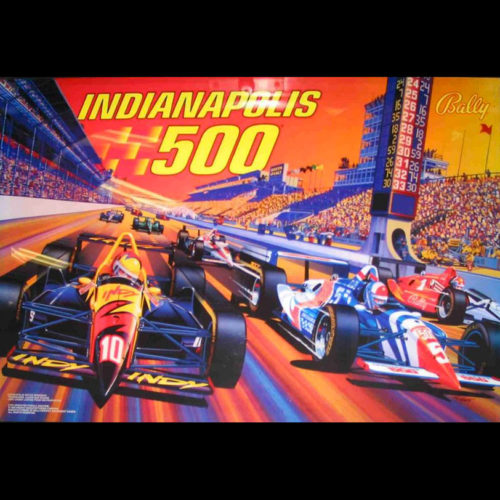
-
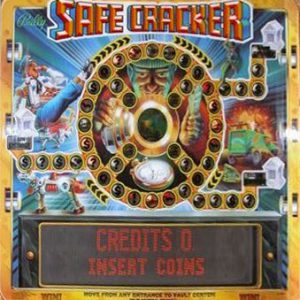 Safecracker is a pinball machine with a safecracking theme, designed by Pat Lawlor, and distributed by Midway (under the Bally label). It was created in 1996. About 1148 were manufactured. Safecracker differs from a standard pinball game in that the player is playing against the clock as opposed to having a certain number of balls available. If the player loses a ball, as long as there is time left on the clock they can continue playing. The machine is smaller in size than a standard pinball machine. The main objective of the game is to break into the bank’s safe. The game can be broken into 3 areas of play: The pinball playfield has numerous targets, the completion of which will allow entry into the bank via the rooftop, the cellar, or the front door. Once the player has entered the bank, the game changes to a boardgame that takes place on the backglass. Using the flipper buttons to make choices, the player rolls dice and moves their piece around the board while being chased by the security guard. The object of this portion of the game is to advance to the center of the game board (where the safe is located) before being caught by the guard. If the player is successful, the game will eject a “magic token” from the bank vault for the player to catch as it rolls down the playfield glass. After the player is done with the regular game, they can deposit their “magic token” into the token slot of the machine to activate a special game mode called “Assault on the Vault”. In this frenzied 4-ball multiball mode, players have 90 seconds to hit as many drop target and ramp shots as possible to break into the bank vault.
Safecracker is a pinball machine with a safecracking theme, designed by Pat Lawlor, and distributed by Midway (under the Bally label). It was created in 1996. About 1148 were manufactured. Safecracker differs from a standard pinball game in that the player is playing against the clock as opposed to having a certain number of balls available. If the player loses a ball, as long as there is time left on the clock they can continue playing. The machine is smaller in size than a standard pinball machine. The main objective of the game is to break into the bank’s safe. The game can be broken into 3 areas of play: The pinball playfield has numerous targets, the completion of which will allow entry into the bank via the rooftop, the cellar, or the front door. Once the player has entered the bank, the game changes to a boardgame that takes place on the backglass. Using the flipper buttons to make choices, the player rolls dice and moves their piece around the board while being chased by the security guard. The object of this portion of the game is to advance to the center of the game board (where the safe is located) before being caught by the guard. If the player is successful, the game will eject a “magic token” from the bank vault for the player to catch as it rolls down the playfield glass. After the player is done with the regular game, they can deposit their “magic token” into the token slot of the machine to activate a special game mode called “Assault on the Vault”. In this frenzied 4-ball multiball mode, players have 90 seconds to hit as many drop target and ramp shots as possible to break into the bank vault. -
 This macabre machine was also one of the most risque games ever made. The vocals are very suggestive as well as the theme of the game. The factory installed a family mode version to the game as well as a cover to the large breasts presented by Elvira on the back glass. Designed by Dennis Nordman and Mark Weyna, the art package came out of the mind of Greg Freres. The object of the game is to complete the six modes represented on the bottom of the playfield. Once all six modes are complete, the object then is to shoot the jackpots with two balls in play all the way up the stiff-o-meter. Doing so produces a pinball fireworks show of light as well as the flippers activating by themselves. The hardest feature on the game is represented in the back glass. If you can achieve all lights by stopping the spider on each and every stop displayed, a special spider multiball is activated. Happy Halloween!
This macabre machine was also one of the most risque games ever made. The vocals are very suggestive as well as the theme of the game. The factory installed a family mode version to the game as well as a cover to the large breasts presented by Elvira on the back glass. Designed by Dennis Nordman and Mark Weyna, the art package came out of the mind of Greg Freres. The object of the game is to complete the six modes represented on the bottom of the playfield. Once all six modes are complete, the object then is to shoot the jackpots with two balls in play all the way up the stiff-o-meter. Doing so produces a pinball fireworks show of light as well as the flippers activating by themselves. The hardest feature on the game is represented in the back glass. If you can achieve all lights by stopping the spider on each and every stop displayed, a special spider multiball is activated. Happy Halloween! -
 This machine is based on the ’30s radio series then turned into a movie. Design accolades go to Brian Eddy with art scripted by Doug Watson. 4,247 of these machines were made. The interesting feature in this machine is the elevated upper-left playfield. This playfield is gained access to once the drop target is hit. Once this challenge is complete, another shot to this ramp shoots the ball upstairs to this feature. Pressing the flipper buttons moves the paddle left or right. The kicker is activated by an optic sensor automatically to hit all the targets if your aim is sure. This game also has a thrust magnet which grabs the ball in action and shoots it up the playfield into the next feature. No pop bumpers are on the playfield, which is a rare event. Another first incorporated into this playfield are two ramp diverters which are player adjustable. Completing the six scenes of the story award you with the final battle sequence of good against evil.
This machine is based on the ’30s radio series then turned into a movie. Design accolades go to Brian Eddy with art scripted by Doug Watson. 4,247 of these machines were made. The interesting feature in this machine is the elevated upper-left playfield. This playfield is gained access to once the drop target is hit. Once this challenge is complete, another shot to this ramp shoots the ball upstairs to this feature. Pressing the flipper buttons moves the paddle left or right. The kicker is activated by an optic sensor automatically to hit all the targets if your aim is sure. This game also has a thrust magnet which grabs the ball in action and shoots it up the playfield into the next feature. No pop bumpers are on the playfield, which is a rare event. Another first incorporated into this playfield are two ramp diverters which are player adjustable. Completing the six scenes of the story award you with the final battle sequence of good against evil. -
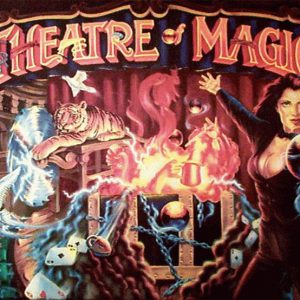 John Popodiuk designed this magical game with artwork penned by Linda Deal. 6,600 units were manufactured. This game is always in the top 10 machines in collectibility. The magic trunk is the centerpiece of the playfield. Its multifunctional sides rotate according to the storyline of the machine at the time. Eight illusions are to be collected in a typical game. This is one of four requirements needed to complete the grand finale stage of the game. Advancing the clock to midnight by shooting the right-side lane 12 times or hitting the captive ball completes this feature. Multiball must be made at the trunk to complete the third part of the puzzle. The last issue is completing the word “theater” by certain ramp shots. Grand finale is tough to achieve but a neat show awaits you. Vanish is another feature that makes a ball disappear when shot up the left-side ramp; the ball reappears when the right ramp is made.
John Popodiuk designed this magical game with artwork penned by Linda Deal. 6,600 units were manufactured. This game is always in the top 10 machines in collectibility. The magic trunk is the centerpiece of the playfield. Its multifunctional sides rotate according to the storyline of the machine at the time. Eight illusions are to be collected in a typical game. This is one of four requirements needed to complete the grand finale stage of the game. Advancing the clock to midnight by shooting the right-side lane 12 times or hitting the captive ball completes this feature. Multiball must be made at the trunk to complete the third part of the puzzle. The last issue is completing the word “theater” by certain ramp shots. Grand finale is tough to achieve but a neat show awaits you. Vanish is another feature that makes a ball disappear when shot up the left-side ramp; the ball reappears when the right ramp is made. -
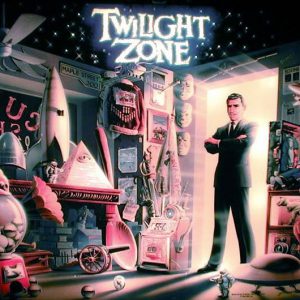 This game is the most complicated solid-state pinball machine for complexity and gadgetry ever made. 15,235 of these were made and design credits go to Pat Lawlor with art by John Youssi. Multiple multi-ball options, magnets, a porcelain power ball a gumball machine and an extra-wide play field are only part of what’s before you. The main object of the game is to complete all the segments of the door in the bottom of the play field. These segments illuminate a light in the door. If by rare chance you complete the feat (you can “buy in” extra balls at the end of your game), all heck breaks loose in the form of a “lost in the zone” ultimate stage in the game. All six balls pop out, every option special, and bonus is lit all at once, and then, as if by magic, the flippers stop working (as this is a timed event) and your bonus is totaled. The battle in the zone magnet-controlled play field and power ball are neat!
This game is the most complicated solid-state pinball machine for complexity and gadgetry ever made. 15,235 of these were made and design credits go to Pat Lawlor with art by John Youssi. Multiple multi-ball options, magnets, a porcelain power ball a gumball machine and an extra-wide play field are only part of what’s before you. The main object of the game is to complete all the segments of the door in the bottom of the play field. These segments illuminate a light in the door. If by rare chance you complete the feat (you can “buy in” extra balls at the end of your game), all heck breaks loose in the form of a “lost in the zone” ultimate stage in the game. All six balls pop out, every option special, and bonus is lit all at once, and then, as if by magic, the flippers stop working (as this is a timed event) and your bonus is totaled. The battle in the zone magnet-controlled play field and power ball are neat! -
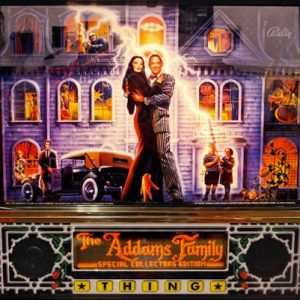 This “special edition” game was produced to recognize the fact that this game, when initially released two years earlier, was the biggest number production game ever made in the contemporary era, with a total production run of 20,270. This game was produced in 1,000 examples. Pat Lawlor designed the machine with John Youssi getting accolades for the artwork. Gadgets abound in this machine, which is augmented by the gold detailing over the standard unit. The main theme here is to complete all 12 parts of the house panel. Doing so brings you to the ultimate level of excitement. Multi-ball options abound as well as “Thing”, consisting of just a hand, grabbing the ball in the upper-right corner of the machine. A magnet under the play field provides strange ball play as well as Thing “flipping” the ball remotely if hit. The sounds and art are fantastic representations from the movie of the same name. This game is #3!
This “special edition” game was produced to recognize the fact that this game, when initially released two years earlier, was the biggest number production game ever made in the contemporary era, with a total production run of 20,270. This game was produced in 1,000 examples. Pat Lawlor designed the machine with John Youssi getting accolades for the artwork. Gadgets abound in this machine, which is augmented by the gold detailing over the standard unit. The main theme here is to complete all 12 parts of the house panel. Doing so brings you to the ultimate level of excitement. Multi-ball options abound as well as “Thing”, consisting of just a hand, grabbing the ball in the upper-right corner of the machine. A magnet under the play field provides strange ball play as well as Thing “flipping” the ball remotely if hit. The sounds and art are fantastic representations from the movie of the same name. This game is #3!